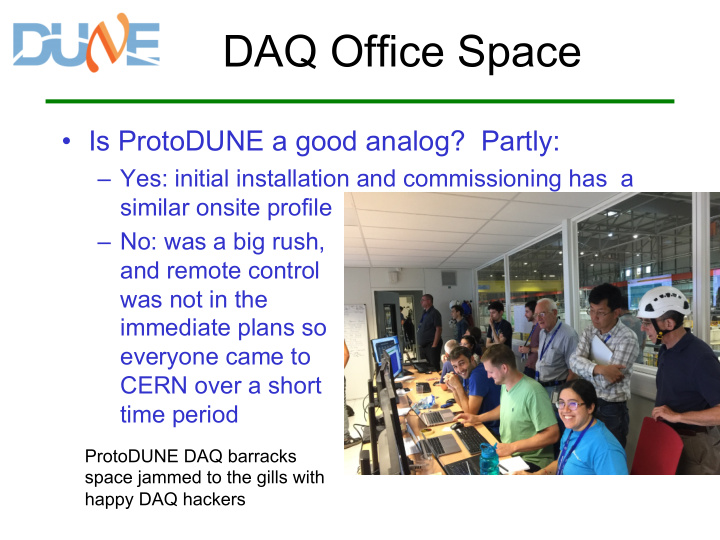



DAQ Office Space • Is ProtoDUNE a good analog? Partly: – Yes: initial installation and commissioning has a similar onsite profile – No: was a big rush, and remote control was not in the immediate plans so everyone came to CERN over a short time period ProtoDUNE DAQ barracks space jammed to the gills with happy DAQ hackers
ProtoDUNE space • ProtoDUNE barracks were fairly small: most work was done by people sitting in B892 • Barracks plus B892 was O(100) desks (!) – But at a lab, people will expand to fill the available space. We have to plan more carefully for a remote site • Some of those many people from the ProtoDUNE example can probably continue to work remotely, so what follows is an estimate of minimum stuff onsite
So, what’s needed at SURF? • For DAQ space, there are five major sub- systems, all getting debugged at once • We can work with three main workstations: – Monitoring, run control, debugging – But also need space for experts with their laptops • Goal is to have as few hands onsite as we can – Supported by people back home or at CERN or FNAL – Ideally not underground, working over network – …but on-site, as they might have to venture underground for physical connections etc
What about non-DAQ operational space? • For run control etc, as non-DAQ people take runs to commission their APAs or whatnot – During Commissioning. For physics data, DAQ RC work won’t be happening, so we might be able to repurpose some of those previous three stations from the last slide – Figure one Run Control plus one Monitoring workstation for commissioning work in parallel to DAQ work – That’s five double-monitor workstations • Other controls (eg, CISC) should be in same room, for easier coordination
Really Rough Layout • 3 DAQ, 2 Commissioning, back-to-back with 5 other workstations, 2m clearances, solely to give order-of-magnitude space
Remote Control • MINOS, MINERvA, and especially NOvA have done a lot to make remote control rooms work well – If those 5-10 workstations become the main control stations for an operational DUNE, simply mirroring them to remote desktops works well – NOvA uses VNC sessions shared by dozens(!) of remote sites, to reduce shift-taking travel costs – Ask a friendly NOvA collaborator to give you a tour of the instance in ROCW (in the FNAL Atrium) to see it in action
What about other space? • If we’re trying to keep people offsite, we will need ( more than one! ) meeting rooms (with videoconferencing) near the previous space: So those offsite experts can meet with their onsite minions to get stuff done • Likely also need offices for quiet work or thinking. 2 small offices w/ 2 people each? • Other groups also likely to need these same two things, so how many in total?
Comparison • CMS’s control room at CERN’s main site, and the smaller one at FNAL is probably not a bad reference point: similarly scaled detectors! – Worked up in detail here: https://lss.fnal.gov/archive/test-tm/2000/fermilab-tm- 2393-e.pdf – Note that we’re not requesting the luxury-car grade accoutrements in the FNAL room – … but alsp note that it’s public outreach components probably are important: linking to a visitor’s center keeps coming up – … and unlike CMS @ FNAL, we will actually have (a lot of) humans there to occupy it
Recommend
More recommend